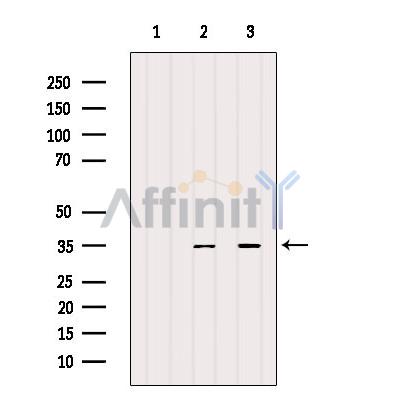SCF Antibody - #AF4113
| 製品: | SCF Antibody |
| カタログ: | AF4113 |
| タンパク質の説明: | Rabbit polyclonal antibody to SCF |
| アプリケーション: | WB |
| 反応性: | Human, Mouse, Monkey |
| 予測: | Pig, Bovine, Horse, Sheep, Rabbit, Dog |
| 分子量: | 25kD(soluble),30~50kd(glycosylated); 31kD(Calculated). |
| ユニプロット: | P21583 |
| RRID: | AB_2835371 |
製品説明
*The optimal dilutions should be determined by the end user.
*Tips:
WB: For western blot detection of denatured protein samples. IHC: For immunohistochemical detection of paraffin sections (IHC-p) or frozen sections (IHC-f) of tissue samples. IF/ICC: For immunofluorescence detection of cell samples. ELISA(peptide): For ELISA detection of antigenic peptide.
引用形式: Affinity Biosciences Cat# AF4113, RRID:AB_2835371.
折りたたみ/展開
C kit ligand; C-kit ligand; Ckit ligand; DCUA; DFNA69; DKFZp686F2250; familial progressive hyperpigmentation 2; FPH2; FPHH; KIT ligand; Kitl; KITLG; KL 1; KL1; Mast cell growth factor; MGF; MGF stem cell factor; SCF; SCF_HUMAN; SF; SHEP7; sKITLG; Soluble KIT ligand; Steel factor; steel, mouse, homolog of; Stem cell factor; Stem cell factor precursor;
免疫原
A synthesized peptide derived from human SCF, corresponding to a region within the internal amino acids.
- P21583 SCF_HUMAN:
- Protein BLAST With
- NCBI/
- ExPASy/
- Uniprot
MKKTQTWILTCIYLQLLLFNPLVKTEGICRNRVTNNVKDVTKLVANLPKDYMITLKYVPGMDVLPSHCWISEMVVQLSDSLTDLLDKFSNISEGLSNYSIIDKLVNIVDDLVECVKENSSKDLKKSFKSPEPRLFTPEEFFRIFNRSIDAFKDFVVASETSDCVVSSTLSPEKDSRVSVTKPFMLPPVAASSLRNDSSSSNRKAKNPPGDSSLHWAAMALPALFSLIIGFAFGALYWKKRQPSLTRAVENIQINEEDNEISMLQEKEREFQEV
種類予測
Score>80(red) has high confidence and is suggested to be used for WB detection. *The prediction model is mainly based on the alignment of immunogen sequences, the results are for reference only, not as the basis of quality assurance.
High(score>80) Medium(80>score>50) Low(score<50) No confidence
研究背景
Ligand for the receptor-type protein-tyrosine kinase KIT. Plays an essential role in the regulation of cell survival and proliferation, hematopoiesis, stem cell maintenance, gametogenesis, mast cell development, migration and function, and in melanogenesis. KITLG/SCF binding can activate several signaling pathways. Promotes phosphorylation of PIK3R1, the regulatory subunit of phosphatidylinositol 3-kinase, and subsequent activation of the kinase AKT1. KITLG/SCF and KIT also transmit signals via GRB2 and activation of RAS, RAF1 and the MAP kinases MAPK1/ERK2 and/or MAPK3/ERK1. KITLG/SCF and KIT promote activation of STAT family members STAT1, STAT3 and STAT5. KITLG/SCF and KIT promote activation of PLCG1, leading to the production of the cellular signaling molecules diacylglycerol and inositol 1,4,5-trisphosphate. KITLG/SCF acts synergistically with other cytokines, probably interleukins.
A soluble form (sKITLG) is produced by proteolytic processing of isoform 1 in the extracellular domain.
Found in two differentially glycosylated forms, LMW-SCF and HMW-SCF. LMW-SCF is fully N-glycosylated at Asn-145, partially N-glycosylated at Asn-90, O-glycosylated at Ser-167, Thr-168 and Thr-180, and not glycosylated at Asn-97 or Asn-118. HMW-SCF is N-glycosylated at Asn-118, Asn-90 and Asn-145, O-glycosylated at Ser-167, Thr-168 and Thr-180, and not glycosylated at Asn-97.
A soluble form exists as a cleavage product of the extracellular domain.
Cell membrane>Single-pass type I membrane protein.
Cytoplasm. Cytoplasm>Cytoskeleton. Cell membrane>Single-pass type I membrane protein. Cell projection>Lamellipodium. Cell projection>Filopodium.
Secreted.
Belongs to the SCF family.
研究領域
· Environmental Information Processing > Signal transduction > MAPK signaling pathway. (View pathway)
· Environmental Information Processing > Signal transduction > Ras signaling pathway. (View pathway)
· Environmental Information Processing > Signal transduction > Rap1 signaling pathway. (View pathway)
· Environmental Information Processing > Signaling molecules and interaction > Cytokine-cytokine receptor interaction. (View pathway)
· Environmental Information Processing > Signal transduction > Phospholipase D signaling pathway. (View pathway)
· Environmental Information Processing > Signal transduction > PI3K-Akt signaling pathway. (View pathway)
· Human Diseases > Cancers: Overview > Pathways in cancer. (View pathway)
· Organismal Systems > Immune system > Hematopoietic cell lineage. (View pathway)
· Organismal Systems > Endocrine system > Melanogenesis.
Restrictive clause
Affinity Biosciences tests all products strictly. Citations are provided as a resource for additional applications that have not been validated by Affinity Biosciences. Please choose the appropriate format for each application and consult Materials and Methods sections for additional details about the use of any product in these publications.
For Research Use Only.
Not for use in diagnostic or therapeutic procedures. Not for resale. Not for distribution without written consent. Affinity Biosciences will not be held responsible for patent infringement or other violations that may occur with the use of our products. Affinity Biosciences, Affinity Biosciences Logo and all other trademarks are the property of Affinity Biosciences LTD.
